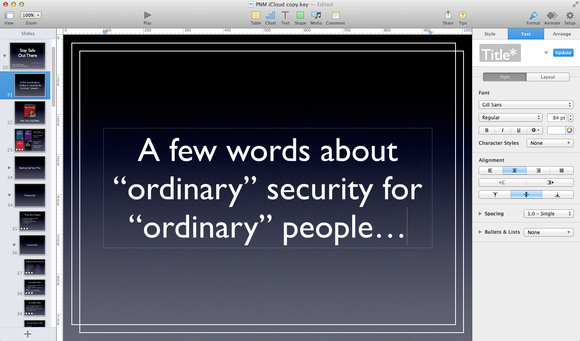Along with a host of other updates this week, Apple shipped new versions of Keynote for both Mac (version 6) and iOS (version 2), and also added new features to the Keynote Web app available on iCloud.com. Here are some first impressions:
Flatter look
The new versions of Keynote adopt the flatter iOS 7 design language, with mostly two-dimensional controls and limited use of color (especially in iOS). Perhaps the most striking change in the Mac version is that the floating palettes are gone: Everything now happens in a single window by default (although you can still bring up a few of the floating palettes if you really want to). And yet, remarkably, Apple managed to make that window feel less cluttered than before without reducing the number of features. I may feel differently after working with it for a while, but so far I’m pleased with the cleaner layout; my slides are no longer buried under all those floating windows.
Shiny new things
Apple has loaded Keynote with plenty of new eye candy, including slick new themes, animations, and interactive charts. Although I prefer to stick with simple, less-distracting visual elements most of the time, there’s nothing wrong with a bit of additional inspiration.
Cross-platform compatibility
Before these new versions appeared, opening a presentation that was created on a Mac in the iOS version of Keynote often meant losing data: Builds, transitions, audio, and other features that weren’t supported in the iOS version were stripped on import. That problem is now, thankfully, gone. All versions of Keynote use the same file format, so you can safely make changes to your presentation on any platform and trust that those changes will remain intact when you view the preso on other platforms.
There is at least one exception, though: The iOS and Web versions of Keynote are limited to the fonts Apple built in, so if you transfer a presentation from the Mac that includes other fonts, you’ll still see a warning message that the text may appear differently.
These new file formats aren’t backward-compatible. You can, however, open files created in earlier versions of Keynote in the new ones, and you can export a presentation in Keynote ’09 format. One consequence of this change is that, if you open an existing presentation in the new iOS version of Keynote, a warning appears telling you that from now on, if you want to open that file on your Mac, you’ll need to upgrade Keynote there, too.
Presenting in style
Keynote now offers both built-in and user-defined styles for paragraphs and text boxes, which (like similar styles in a word processor or page-layout app) make it easier to keep the appearance consistent throughout a presentation and easily make global changes at a more granular level than master slides permit. Master slides are better than before, however: They’re easier to edit and can have their own guides, separate from per-slide guides.
Take a note
Assuming you have at least two displays (Keynote now supports up to six) it has long been possible to put Presenter Notes on a display that is visible to you but not to the audience. Presenter Notes are still there, with a twist: you can now edit these notes while you’re giving your presentation. If an audience member makes a perspicacious comment you want to come back to (or mention the next time you give the presentation), you can jot it down without even pausing your presentation.
Mobile power
A handful of features previously available only in the Mac version of Keynote have made their way into the iOS version too. For example, you can now use Instant Alpha to knock the background out of an image on your iPhone or add a soundtrack to your presentation on your iPad.
Share everywhere
All versions of Keynote sync documents via iCloud; you can also use the Share button to send a presentation in any of several formats (or links to your presentation on iCloud, if you prefer) via Mail, Messages, Twitter, Facebook, and other channels. In fact, you can even invite others (including Windows users) to edit your presentation in a Web browser—a level of collaboration far beyond what Keynote ever offered before.





